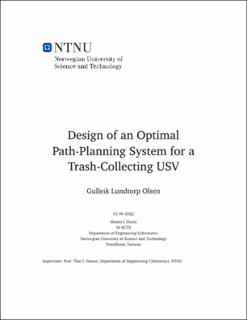| dc.contributor.advisor | Fossen, Thor Inge. | |
| dc.contributor.author | Olsen, Gulleik Lundtorp. | |
| dc.date.accessioned | 2022-09-20T17:22:14Z | |
| dc.date.available | 2022-09-20T17:22:14Z | |
| dc.date.issued | 2022 | |
| dc.identifier | no.ntnu:inspera:102231297:37553257 | |
| dc.identifier.uri | https://hdl.handle.net/11250/3019944 | |
| dc.description.abstract | Denne rapporten omhandler videreutviklingen av Clean Sea Solutions Cleaning Drone V1 (CDV1). Oppgaven var tredelt. Det første punktet handler om å få den veipunktgenererende algoritmen utviklet i forfatternes prosjektoppgave til å styre dronen gjennom Robotic Operating System (ROS). Baneplanleggingssystemet ble kjørt i ROS på en datamaskin fra land. En nettverksmodul sendte deretter dataene til og fra det isolerte kontrollsystemet til CDV1. CDV1 ble deretter kjørt med det nye baneplanleggingssystemet i et lite testområde i Trondheims havnebasseng. Andre punkt innebærer å evaluere og teste dagens design av dronen. Dronens nåværende design ble testet ved at dronen ble manuelt styrt inn i søppelopphopninger på vannet for å evaluere dens søppeloppsamlingssevne. Til slutt ble en metode for å unngå hindringer lagt til systemet og testet i en simulator. Objektunngåelse ble gjort ved hjelp av baneplanleggingsalgoritmen D* Lite og testet i en simulator. D* Lite kunne enkelt styre dronen unna land og ukjente hindringer. Veiplanleggingen ble også forbedret ved å legge til virtuell polstring på hindringer og ved å øke antall søkeretninger. | |
| dc.description.abstract | This thesis further develops Clean Sea Solutions Cleaning Drone V1 (CDV1). The task was threefold. Firstly, the waypoint-generating algorithm created in the authors' specialization project will be used to control the drone through Robotic Operating System (ROS). The guidance system was run in ROS on a computer on land. A network module then transmitted the data to and from the isolated control system of the CDV1. The CDV1 was then run using the new guidance system in a small test area in Trondheim's harbor basin. Secondly, the current design of the drone will be tested and evaluated. To test the design of the current drone, the Cleaning Drone was manually steered into collections of trash to evaluate its trash-collecting capabilities. Lastly, a method for avoiding obstacles was added to the system and tested in a simulator. Object avoidance was done using the pathplanning algorithm D* Lite and tested in a simulator. D* Lite could easily steer the USV clear of land and unknown obstacles. The pathplanning was also improved by adding padding to obstacles and increasing the search direction. | |
| dc.language | eng | |
| dc.publisher | NTNU | |
| dc.title | Design of an Optimal Path-Planning System for a Trash-Collecting USV | |
| dc.type | Master thesis | |
